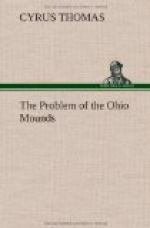It is at least apparent that the ancient works of the Kanawha Valley and other parts of West Virginia are more nearly related to those of Ohio than to those of any other region, and hence they may justly be attributed to the same or cognate tribes. The general movement, therefore, must have been southward as indicated, and the exit of the Ohio mound-builders was, in all probability, up the Kanawha Valley on the same line that the Cherokees appear to have followed in reaching their historical locality. It is a singular fact and worthy of being mentioned here, that among the Cherokee names signed to the treaty made between the United States and this tribe at Tellico, in 1798, are the following: [Footnote: Treaties between the United States of America and the several Indian tribes (1837), p. 182.] Tallotuskee, Chellokee, Yonaheguah, Keenakunnah, and Teekakatoheeunah, which strongly suggest relationship to names found in the Allegheny region, although the latter come to us through the Delaware tongue.
If the hypothesis here advanced be correct, it is apparent that the Cherokees entered the immediate valley of the Mississippi from the northwest, striking it in the region of Iowa. This supposition is strengthened not only by the similarity in the forms of the pipes found in the two sections, but also in the structure and contents of many of the mounds found along the Mississippi in the region of western Illinois. So striking is this that it has been remarked by explorers whose opinions could not have been biased by this theory.
Mr. William McAdams, in an address to the American Association for the Advancement of Science, remarks: “Mounds, such as are here described, in the American Bottom and low-lands of Illinois are seldom, if ever, found on the bluffs. On the rich bottom lands of the Illinois River, within 50 miles of its mouth, I have seen great numbers of them and examined several. The people who built them are probably connected with the Ohio mound-builders, although in this vicinity they seem not to have made many earthen embankments, or walls inclosing areas of land, as is common in Ohio. Their manner of burial was similar to the Ohio mound-builders, however, and in this particular they had customs similar to the mound-builders of Europe.” [Footnote: Proc. Am. Assoc. Adv. Sci., 29th (Boston) meeting, 1880 (1881), p. 715.] One which he opened in Calhoun County, presented the regular form of the Ohio “altar.”
A mound in Franklin County, Ind., described and figured by Dr. G. W. Homsher, [Footnote: Smithsonian Report for 1882 (1884), p. 722.] presents some features strongly resembling those of the North Carolina mounds.
The works of Cuyahoga County and other sections of northern Ohio bordering the lake, and consisting chiefly of inclosures and defensive walls, are of the same type as those of New York, and may be attributed to people of the Iroquoian stock. Possibly they may be the works of the Eries who, we are informed, built inclosures. If such conclusion be accepted it serves to strengthen the opinion that this lost tribe was related to the Iroquois. The works of this type are also found along the eastern portion of Michigan as far north as Ogemaw County.




